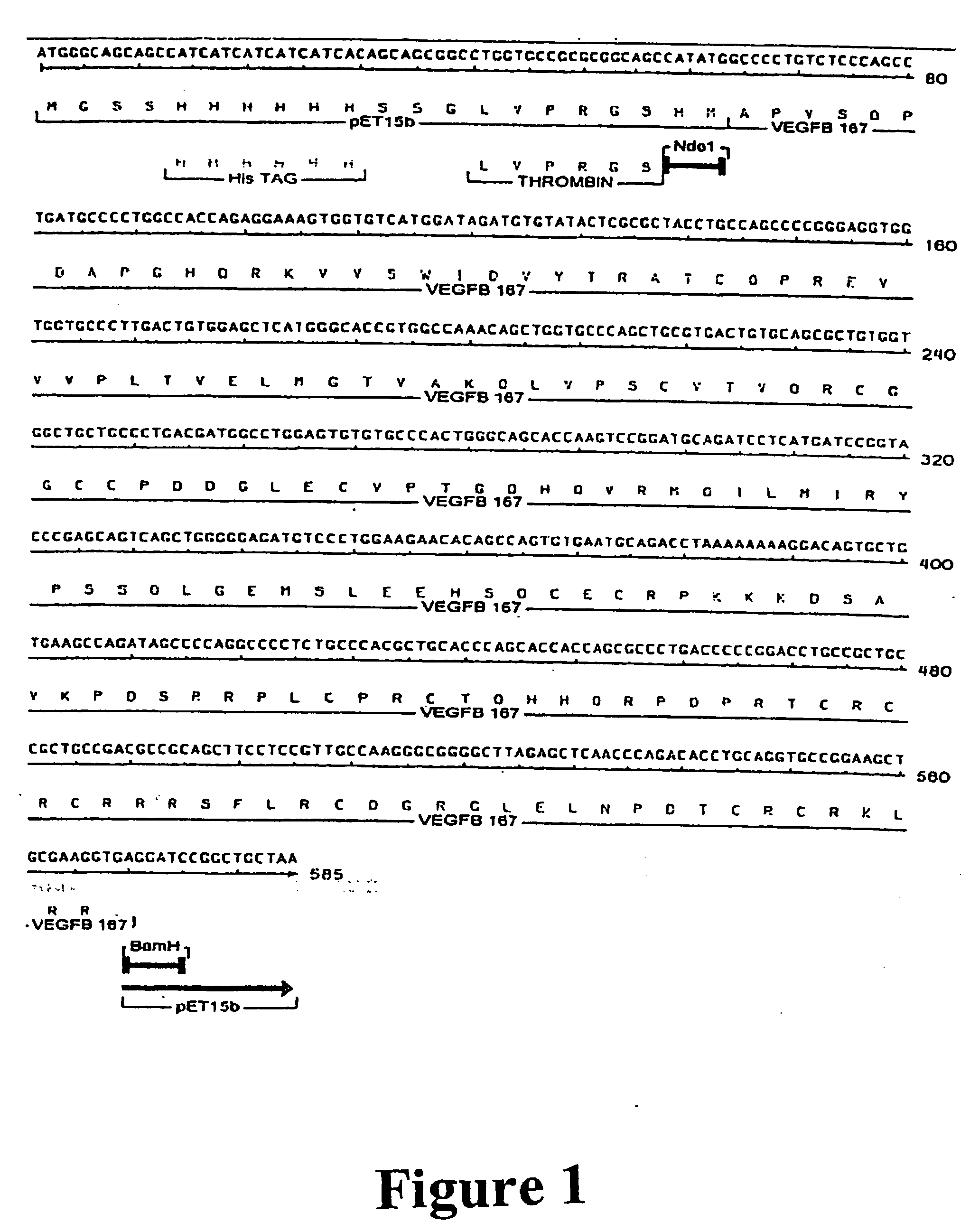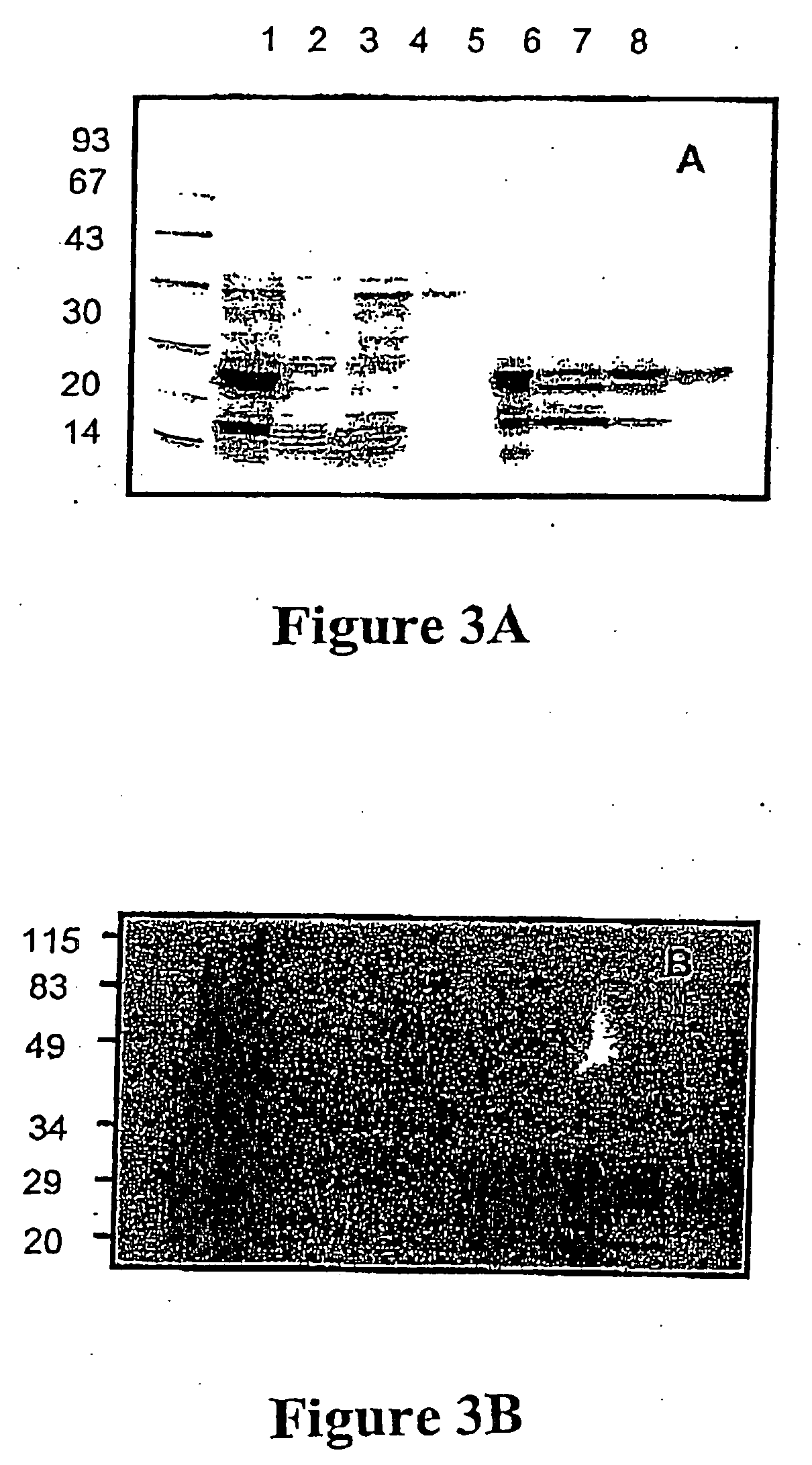Purification of vascular endothelial growth factor-B
- Summary
- Abstract
- Description
- Claims
- Application Information
AI Technical Summary
Problems solved by technology
Method used
Image
Examples
example 1
His6-Tagged Human VEGF-B167 Expression Vector
pET15b-VEGF-B167
[0081] The coding region of the mature human VEGF-B167 protein was amplified using PCR (94° C. / 2 min—1 cycle; 94° C. / 15 sec, 60° C. / 15 sec, 72° C. / 2 min—35 cycles; 72° C. / 5 min B 1 cycle; Stratagene pfu turbo; Corbett Research PC-960-G thermal cycler) to introduce in frame Nde I and BamH1 restriction enzyme sites at the 5′ and 3′ ends, respectively, using the following oligonucleotides:
5′ Oligo5′-ATATCATATGGCCCCTGTCTCCCAGCSEQ ID NO: 1CTGATGC-3′3′ Oligo5′-TATAGGATCCTCACCTTCGCAGCTTCSEQ ID NO: 2CGCACCT-3′
[0082] The resulting PCR derived DNA fragment was gel purified, digested with Nde I and BamH1, gel purified again, and then cloned into NdeI / BamH1 digested pET15b (Novagen, Madison Wis., USA). When expressed in E. coli the VEGF-B167 protein has an additional 21 amino acids at the N-terminus that incorporates a hexa-His tag and a thrombin cleavage site (FIG. 1).
example 2
Expression of His6-Tagged VEGF-B167 in BL21(DE3) GOLD E. coli Cells Using pET15b-VEGF-B167
[0083] pET15b-VEGF-B167 was transformed into BL21(DE3) GOLD E. coli (Stratagene, Catalogue #230132) using an Electroporator (BioRad, USA) according to the manufacturer's instructions. The transformation reaction was plated onto LB ampicillin plates and incubated overnight at 37° C. Four ampicillin resistant colonies were picked, grown overnight and DNA extracted using a standard miniprep protocol (Bio101). Miniprep DNA was analyzed using the restriction enzymes BamH1 and Nde1. A colony giving the appropriate fragment was used for preparation of a glycerol stock for subsequent studies.
[0084] For preparation of a seed culture a 50 ml LB broth (10 g tryptone, 5 g yeast extract, 5 g NaCl, pH 7.0) was inoculated with pET15b-VEGF-B167 transformed BL21(DE3) GOLD from the glycerol stock. The culture was allowed to grow at 37° C. (with continuous shaking) to OD600 0.7 and stored at 4° C. until require...
example 3
Isolation of His6-Tagged VEGF-B167 Inclusion Bodies
[0086] Frozen cell pellets were thawed and 3 ml lysis buffer (50 mM Tris-HCl, pH 8.0, 1 mM EDTA, 100 mM NaCl) was added per gram of cells. Once thoroughly mixed, 40 μl PMSF (10 mM) (phenylmethylsulfonyl fluoride: Sigma-Aldrich, USA) and 40 μl lysozyme (20 mg / ml) were added per gram of cells. The solution was mixed thoroughly and allowed to stand for 30 min at 37° C. Deoxycholic acid (4 mg / gram cells) was added and the solution mixed until viscous. DNase I (1 mg / ml: 20 μl / g of cells) was mixed with the cell lysate and allowed to stand for 30 min at 37° C., or until no longer viscous. Insoluble material (including inclusion bodies) was pelleted by centrifugation at 13,500 rpm for 30 min at 4° C. (FIG. 2).
Washing of Inclusion Bodies
[0087] Pelleted insoluble material was resuspended in 35 ml of 100 mM Tris-HCl, pH 7.0, 5 mM EDTA, 10 mM DTT, 2 M urea, 2% v / v Triton-X100 (Buffer 1) per litre of starting fermentation produc...
PUM
| Property | Measurement | Unit |
|---|---|---|
| Length | aaaaa | aaaaa |
| Basicity | aaaaa | aaaaa |
| Affinity | aaaaa | aaaaa |
Abstract
Description
Claims
Application Information
 Login to View More
Login to View More - R&D
- Intellectual Property
- Life Sciences
- Materials
- Tech Scout
- Unparalleled Data Quality
- Higher Quality Content
- 60% Fewer Hallucinations
Browse by: Latest US Patents, China's latest patents, Technical Efficacy Thesaurus, Application Domain, Technology Topic, Popular Technical Reports.
© 2025 PatSnap. All rights reserved.Legal|Privacy policy|Modern Slavery Act Transparency Statement|Sitemap|About US| Contact US: help@patsnap.com



